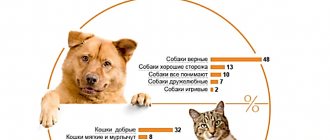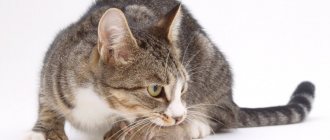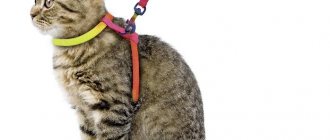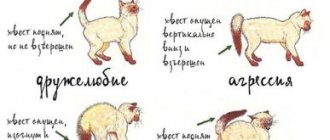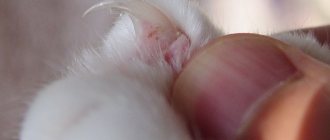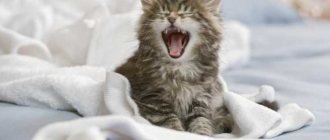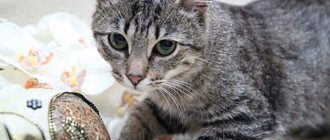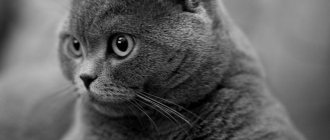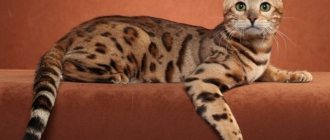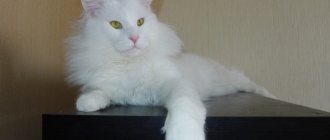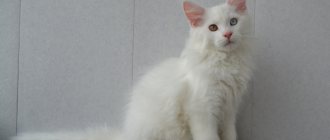Smoky beauty from the Australian continent
- Fact 1:
The word "mist" in English means "fog". - Fact 2:
Mists have a small muzzle, slightly tapering from the forehead to the chin. - Fact 3:
Despite their easy-going nature, cats sometimes need to play and run around. - Fact 4:
Good news for future owners - representatives of this breed practically do not shed.
Australian Mists are ideal family pets. Affectionate and friendly, absolutely easy to care for. But, unfortunately, very rare. It is currently impossible to buy such a cat in a Russian nursery.
How the breed originated
The name of the breed is not accidental. The word "mist" in English means "fog". The animals have a smoky color. “Australian” refers to the homeland of pets. This is the only breed that was bred in Australia. To get it, several types of cats were crossed:
- outbred - gave a spotted pattern on the coat;
- Burmese - sociability and physique;
- Abyssinian – intelligence, smoky color.
Breeders took only the best qualities from all animals. As a result, playful, moderately sociable and absolutely undemanding pets appeared.
Origin story
For the birth of a unique breed, we must thank the female scientist Trude Strayed from Australia. An animal lover, a workaholic and a pedant by nature, she sought to embody all the positive qualities in one cat: love and devotion to her owners, ease of care, intelligence and independence. This is exactly what the scientist believes an ideal four-legged friend should be like.
After much breeding work, which began in 1975, a unique formula for the new breed was developed. The Australian Mist is a cat that contains the blood of 30 different representatives of different breeds, which include genes from the Burmese, Abyssinian and mongrel shorthairs. Each breed made its contribution, and after much testing, in 1986 the world saw the first purebred kittens. In 1998, the breed was officially registered, receiving the name Spotted Mist. Later, due to the presence of not only spots, but also marbled stripes in the color, the name was renamed Australian Mist (Australian Smoky Cat).
Mystics live mainly in their homeland - Australia, and meeting them in European countries was considered very rare. The first specimens were brought to England by Mary Stuart, who subsequently increased the number of “purebreds” to 200 specimens. Today, having undergone training and received official permission from the Australian “parents”, breeders in several countries have begun breeding this breed. Several lines of mists have appeared, with their own characteristic colors. Breeders in Norway and the USA are working on developing new lines of “smoke”.
Appearance and standard
It cannot be said that Australian mysts are distinguished by their exotic appearance. These are animals with a slender, muscular body of medium size. The weight of an adult cat is approximately 4.5 – 5 kg. Cats weigh about 1 kg less.
Mists have a small muzzle, slightly tapering from the forehead to the chin. Ears set wide apart, slightly tilted forward. Big round eyes. According to the standard, they must be green (any shades of this color are acceptable).
Cats don't have very long legs. Strong, but not massive. The paws are oval. Mists should have a long tail. Thicker at the base, gradually tapering towards the tip.
Breed standard and description
There is no extreme in the rock itself - the “fog” is perfectly balanced. Males, as expected, are larger and more muscular than females. The head is of medium length and surprises with its width and softly rounded contours, round cheekbones.
Wide, moderately short nose and strong chin, well-developed mustache, large ears, wide at the base, set fairly low and slightly tilted forward. The tips of the ears are specifically rounded.
From the very first second, attention is drawn to the brilliant huge eyes of this cat, which make an indelible impression. They are slightly slanted, almond-shaped, green or aquamarine in color with a golden iris. Animals with amber, dark brown and bright yellow eyes are subject to disqualification.
Solid and rather heavy body, medium length, with a wide chest. He just exudes muscle strength. Strong legs, also of medium length with strong oval-shaped paws. Quite a thick long tail. The length of the tail is slightly less than the length of the body, it tapers towards the end, and the tip itself is neatly rounded.
A glossy short coat, denser than the Burmese. The size of the Australian Mist cat is small, it is neat and graceful. The weight of the animal is 3.5 – 6 kg. Such weight with a deceptive compactness became a specific feature of these cats - they inherited it from their Burmese “relatives”, who were not without reason nicknamed “bricks in a silk shell”.
In addition to the most beautiful eyes, as if lined with a dark color, perhaps the main feature of the breed can be called the color of this cat. For such a rare tick, breeders fought a rather long and stubborn struggle. After careful work, six color options were developed: gold, lilac, caramel, blue, brown and peach. But all the fur is covered with a bizarre pattern of stripes and spots. Thanks to Tikit, the cat's entire body seems to be covered in an invisible mantle. The undercoat is well developed, and the coat is short, thin and soft, silky, and does not lie too tightly to the body.
Requirements for color and coat
Australian Mists have a pleasant to the touch, very thick and soft coat. Acceptable color options, which are fully manifested only by the 2nd year of life:
- faun;
- lilac;
- shade of cinnamon;
- chocolate.
Thanks to the genes of the Abessinian cat, the color has ticking - alternating dark and light stripes on the hair. Because of this, the color of the coat appears smoky. The remaining components of the color are the background and the pattern (darker).
According to the standard, the coat color should be rich, lighter on the belly. The drawing is symmetrical and clear. There are no requirements for the size and shape of the marks. A prerequisite for compliance with the standard is a reddish tint of the hairs on the face.
Mist coat color
The color features of the animals distinguish the Mists from other breeds. Cats have a coat of a primary color, a dark pattern in the form of spots or marbles, covered with a light haze on top. The latter effect gave the name Australian smoky. The pattern is most clearly expressed on the back, and the stomach is almost uniform. The standard allows several shades of ticketing:
- brown;
- caramel;
- blue;
- lilac;
- gold;
- peach;
- chocolate.
Brown Australian Mist
Kittens are born with a pale color of a reddish tint in some places. As they grow older, around the age of two, the coat becomes saturated and the “quality” of the breed can be determined by the following criteria:
- the color of the mist's coat should be bright and warm;
- the lower part is lighter than the top;
- reddish pattern on the nose, ears and cheeks, regardless of the main color;
- the spots of the pattern can be of different shapes and sizes, but must be located symmetrically;
- the marble pattern can be broken up with light inclusions;
- Even with the lightest shade of wool, the pattern must be present.
For “purebreds,” the color saturation should predominate in the area of the nose, ears and cheeks, otherwise the cat will not pass the standard test.
Character
The main goal of Australian breeders was to create the ideal pet. They completed this task 100%. Mystics have a very calm and balanced character. They will never annoy their owners with loud meows or obsessive behavior.
Despite their easy-going nature, cats sometimes need to play and run around. Although too much physical activity is not required. Kittens are always more active. Adults are much calmer. Friendly Mists get along well with all family members. Families with children can safely have such pets.
The only thing Australian mysts need is attention and care. When they are lacking, animals begin to get bored. Therefore, it is better not to leave them alone for a long time.
Australian Mist Standard
In English, the word “mist” is translated as “fog.” This most accurately reflects the main feature of the Australian cat: its fur seems to be covered with a light haze. The Australian Mist is a medium-sized cat of a foreign body type, combining the best breed traits of its ancestors.
The mist is due to a combination of the sepia and agouti genes, but it is much blurrier and softer than other ticked colors and gives a hazy effect to the coat.
Standard:
- Head: Shape - a wide modified wedge with soft rounded contours.
- The width of rounded cheekbones is proportional to the width of the skull.
- The junction areas of the nose, cheeks and inner corners of the eyes form noticeable indentations on either side of the bridge of the nose.
- The eyes are medium to large in size, set slightly at an angle towards the nose. The upper eyelid is almost straight, while the lower eyelid, on the contrary, is almost round. The distance between the eyes is not less than the width of one eye. Color: Tonkinese aquamarine, Chartreuse copper or green.
- The ears are moderately large, the bases are wide, and the tips are rounded. Set not high, but not low either, slightly inclined forward and to the sides from each other.
- The muzzle is pronounced, but not wide.
- The whisker pads are quite large and well developed. They have a relatively similar shape with the chin and nose and together with them resemble a four-leaf clover. When viewed from the side, the chin and tip of the nose form a vertical or slightly sloping line.
- The chin is strong, wide, balancing the width of the nose.
- The nose is wide, moderately short.
- The profile of the muzzle shows a soft curve to the nose. The lines of the forehead and nose are of equal length.
- The neck is of medium length, proportional to the head and body, smoothly blending into the line of the back.
- The torso is of medium length, together with the paws it forms a rectangle.
- Coat length: short.
Overmasking among mysts is the merging of a pattern into a wide stripe on the back
- brown: base color is warm dark ivory;
- main color - warm light blue;
- the main color is the same for everyone - a warm cream-fawn with a barely noticeable cold metallic tint;
- main color - warm cream fawn;
- main color - warm delicate champagne;
- main color - warm cream;
- main color - creamy pink;
- lighter color than expected in kittens;
- the tail is longer than the body and/or tapers towards the tip;
- white markings on the neck (medallions);
- malocclusion, overbite or underbite;
Photo gallery: Australian Mist colors
Brown marbled Mists have a basic color tone of warm ivory.
The Brown Spotted Australian Mist has a brick-colored nose.
Blue marbled mysts are one of the most spectacular cats Blue spotted mysts adopted the color from Abyssinian cats, and the pattern on it from domestic cats
The caramel spotted color is very rare in Mists.
The pattern of the golden marble mists is much darker than the background
In golden spotted mysts, the pattern often almost merges with the background
Chocolate marble mists have a pronounced contrast between the colors of the background and the pattern
In chocolate spotted mysts, the reddish “patina” on the ears and face is especially clearly visible
Lilac marbled mysts are one of the most beautiful cats
In childhood, the pattern of lilac spotted mysts is almost invisible. The spotted peach color is also called fawn-spotted or peach-spotted.
The color of marbled peach mysts is finally formed by the age of 2
Content Features
Australian Mists are classic domestic cats and real homebodies. They live comfortably even in a small apartment. They are not very active, so walking outside is not necessary. Although, if the owners wish, cats can be trained to a leash and occasionally taken out into the fresh air.
Kittens are usually litter box trained at an early age, so future owners should not have any problems. Animals quickly remember where the toilet is, a place to sleep and feed. For cats, you can buy a high scratching post. The pet will be able to play independently and at the same time sharpen its overgrown claws.
Character and behavior
Dr. Strayed dreamed of breeding a pet that was ideal not only in appearance, but also in character. Whether the Australian myst is an ideal is a controversial issue, but one thing is certain: representatives of this species are very complacent and affectionate.
Australian mystic is all about calm and tranquility. He has an easy-going character and gets along well with both people and other animals. He loves children very much, especially small ones: he plays with them with pleasure, looks after them and protects them, and will never allow himself to let out his claws or bite a toddler. A cat can be left even with infants without fear: it feels that it is forbidden to climb into the baby’s cradle.
Does not tolerate loneliness: representatives of this breed require the obligatory presence of a person at home. Strong affection is both a big plus of this breed, but also a minus. When choosing a master, the mist will follow him around and get bored, parting for a long time.
He comes running when called, like a dog, but if the owner is doing something, he will not crawl under his arms, but will lie nearby and wait for him to finish. But you will be only too happy to “watch” TV or “read” the newspaper with your loved one.
But they don’t require a lot of physical activity, just like walking outside: your pet will feel great in the apartment, walking along the backs of the sofas and watching the birds from the window.
Does your pet like to go for walks?
HomebodyWalking on the street
He sits with great pleasure in his arms, walks calmly on a leash and can withstand long car rides. Not afraid of guests. She remembers simple commands well and quickly, she can even learn tricks. They love to play with toys and climb on shelves and cabinets. He doesn’t meow in vain, so if your pet starts making loud noises, look to see if he has run out of food, is it time to change the water in the bowl or clean the tray?
Australians are so kind-hearted that they will calmly take in a stray kitten and raise it as their own.
Care
The Australian Mist is very easy to care for. Good news for future owners - representatives of this breed practically do not shed. Periodically, they can be brushed with a brush with natural bristles. You need to bathe as needed.
The rest of the care comes down to the procedures required for all cats:
- regular examination of teeth and oral cavity;
- ear cleaning;
- washing the eyes.
Nail trimming will not be necessary if your pet has a good scratching post.
Care and maintenance
Mists are distinguished by increased cleanliness. A small undercoat does not lead to excessive shedding, so grooming requires minimal effort. Read about what to do if your cat begins to shed heavily.
It is better to comb your pets with a massage brush with rubber teeth, then the procedure will bring them pleasure. There is no need for frequent bathing. Eyes and ears should be cleaned only as needed.
Claws are trimmed no more than once a month.
Mists get used to the toilet and scratching post easily. It is necessary to monitor the cleanliness of the tray; cats may simply not go into a dirty one. It is better to purchase a fairly large play complex for your apartment; these animals love heights.
Health
Australian mysts can be called long-lived. With proper care, pets will live 15–20 years. Cats have fairly good health and good immunity. The only ailments that representatives of the breed are prone to are:
- excess weight is a consequence of a sedentary lifestyle and overeating;
- kidney stones are the result of feeding only dry formulas;
- stomach upsets that occur when changing food.
Preparing a balanced diet, which must contain natural products, will help you avoid the first two problems.
Proper care and health of the Australian Mist cat breed
One of the many advantages of the Australian mist is its ease of care. The only negative is its super-strong attachment to its owner. When left alone for a long time, the animal begins to feel sad. Therefore, if you are often away from home, then the Australian Mist cat breed is not for you.
Smoky breed cats practically do not shed, you do not have to pick out fur from food or shake it off clothes. From time to time, brushing the fur with a brush is all it takes to care for it. Australian cats have good health, but you should not overfeed them, as there is a risk of the animal developing obesity. Excess weight will lead to more serious problems: diabetes, cardiovascular diseases, etc. Veterinarians recommend calculating the daily food intake at 75 kcal per 1 kg of animal weight. Mystics eat whatever is offered to them. These can be natural products or ready-made food.
In the house where an Australian lives, there should be a minimum set: a tray with filling, a scratching post and a couple of toys to diversify the animal’s exercise. If you leave without leaving any interactive toys for your pet, he will get bored and find entertainment on his own, which you are unlikely to approve of.
There is most likely no danger for the owner to toilet train a cat. Since this breed is rare, you can only find and buy Mist from trusted breeders or specialized nurseries. Such animals, as a rule, should already be familiar with the peculiarities of personal hygiene.
In short, there will be no problems with the “smoke” in terms of care. Sometimes clean the ears, wipe the eyes and brush the fur once every couple of weeks - this is the entire minimum program that the owner will have to complete.
As for the health of mystics, hereditary ailments are not common to them. Good immunity makes animals of this breed long-lived. Cats can please their owners for 15-20 years. But no matter how good the gene pool of mystics is, the conditions and specifics of their maintenance can adjust the life cycle to a lesser extent. To maintain the health of your pet, follow these rules:
- nutrition should be regular and balanced;
- monitor the quality of food and water;
- there must be a good microclimate in the room where the mist lives;
- provide him with leisure time so that the animal does not sit too long and get bored when you are not around;
- do not allow the mist to approach strange animals from the street.
The list of vaccinations for Australians is minimal, the main ones being injections against parasites.
Features of feeding
Australian mists are easy to care for. But you should approach feeding your pets responsibly. Firstly, cats are prone to excess weight and have an excellent appetite. You cannot overfeed them.
Secondly, the pet’s diet should consist not only of ready-made food, but of natural products. Dry mixtures often provoke the appearance of kidney stones. Australian Mists enjoy eating meat:
- boiled beef;
- chicken (not raw);
- ground beef (for kittens);
- offal.
In no case should there be bones in the meat. The pet may choke or damage its teeth.
A physiological feature of the breed is short-term stomach upset when changing food. Owners should not be alarmed. The body needs several days to get used to the new diet.
Kittens up to six months are fed several times a day in small portions. Gradually the number of meals is reduced to twice a day. Regardless of age, the animal should always have access to fresh drinking water.
Health and vaccinations
Australian Mists are a relatively young breed of cats, so it is too early to talk about systematic or chronic diseases. Cats that are well cared for are known to live up to 15 years or longer.
Scientists consider excess weight, which Australian mysts gain relatively quickly, to be one of the recorded problems. The cats become lethargic, move little, experience shortness of breath, and the main bones of the skeleton are difficult to palpate. Then problems with joints, heart and liver begin.
When a cat weighs 20% more than it should, it is considered obese. From now on, the pet requires a balanced diet, vitamins and an active lifestyle. in rare cases, hormonal medications are required.
The vaccinations required for the Australian Mist are identical to all other breeds. At the age of 9-12 weeks, the first anti-infective vaccines and rabies vaccinations are given, after which they are repeated at the required frequency, and then the cats are vaccinated once a year. The exception is when a cat goes on a trip with its owners, then the list of vaccination requirements expands. These data can be clarified with veterinarians.
Where to buy a kitten
When purchasing an Australian Mist kitten, future owners will face only one problem. There are no nurseries in Russia that breed the breed. These cats are still very rare.
Purchasing through an ad carries a lot of risks. There is no guarantee that the animal is truly a purebred representative of the breed. Therefore, when deciding to buy a kitten, you should carefully weigh the pros and cons. Check the reputation of the breeder or seller, carefully study the baby’s documents.
Appearance
The Australian Mist has a cute and attractive appearance, and there is also an established breed standard.
Dimensions and weight
Mist has moderate dimensions: the weight of females varies between 3-6 kg, males can weigh 4-8 kg.
The Mist cat has a graceful but athletic body
Anatomical features
Mist has a slender body with a pronounced and strong chest. Paws are large with dense round pads. The fluffy tail is narrowed towards the end, the muzzle is rounded, with sharp and clear cheekbones, with a well-defined chin.
Representatives of the breed have an elegant and calm appearance
The nose is short, without humps or hills. The ears are large and widen towards the base. The color of the mist's eyes is almost always green with a variety of shades, they are large in size and have an oriental cut.
Color and coat type
The mist's coat is multi-layered and has a smooth ticking, under which you can see a smoky or marbled spotted pattern. The general “painting” is distinguished by noticeable shading, which is why the mist is sometimes called the “smoky Australian cat”, since the color of the animal resembles densely enveloped smoke or fog.
IMPORTANT: the breed was originally called “spotted mist” due to the specific smoky color of the coat.
The breed must have ticking
Spotting can be of any shape and any color, but with one exception: the spots are always symmetrically scattered throughout the coat. Sometimes they can be diluted with a lighter tone. Among the most common colors:
- Chocolate
- Golden
- Pale yellow
- Lilac
- Blue
The background of the coat is usually light; on the ears and nose it can have a reddish tint. The lower part, especially the tummy and the inside of the legs, may be lighter than the head. Kittens are born paler, often white, and acquire their signature color as they approach one year of age.
Possible breed defects
There are disadvantages due to which a cat cannot receive a high rating at an exhibition and is not intended for further breeding:
- Not green eyes
- No ticked color
- Too graceful skeleton
- Small eyes without a cut
- Weakened muscle tone
- Little ears
- Pinch
- Too smooth and shiny coat
A pet may be disqualified for not having green eyes.
